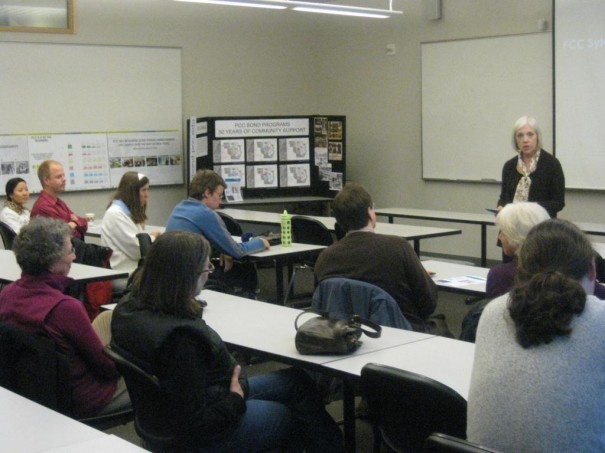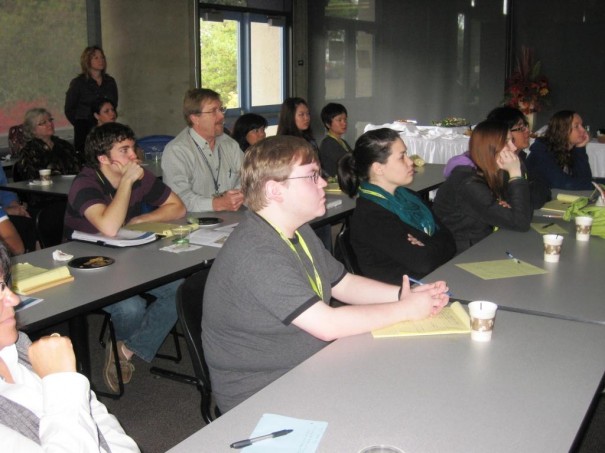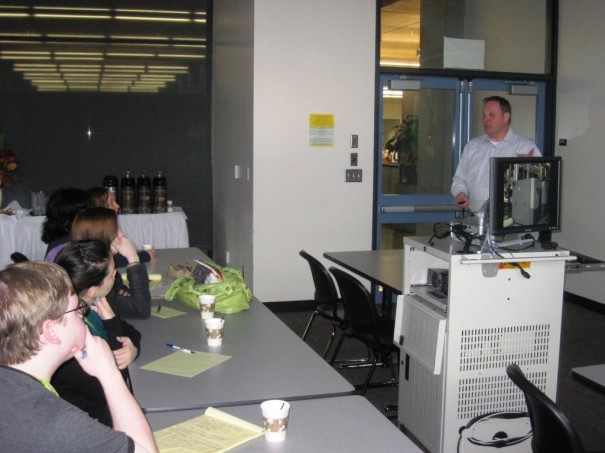This content was published: December 15, 2011. Phone numbers, email addresses, and other information may have changed.
Neighbors and PCC students and staff get a “snapshot” of completed and planned bond-funded improvements at Sylvania Campus
Photos and Story by Gina Whitehill-Baziuk
As PCC celebrates its 50thanniversary this year, the Sylvania Campus – PCC’s oldest and largest — has begun a long-term renovation project to modernize and “green” campus buildings constructed in the 1960s when concrete and “brutalistic” architecture were all the rage.

Linda Gerber, Sylvania Campus president, addressed a crowd of more than a dozen faculty, staff and neighborhood leaders who wanted to learn about bond-funded improvements at the campus.
“Our campus is old and in need of a considerable amount of updates,” said Linda Gerber, president of the Sylvania Campus. “The design and construction work under way at Sylvania protects the community’s public assets, at the same time it will bring the academic and student services needs in line with current standards and practices.”
The latest on what has been accomplished since work commenced last year – as well as future plans – was shared recently at two open houses hosted on November 1, 2011, for interested faculty, staff and students. Neighbors who live near the campus and representatives from nearby neighborhood associations also attended the sessions, which attracted nearly 40 throughout the day. Questions ranged from anticipated timelines, to construction schedules, to services for students in the to-be-remodeled College Center building which serves as a student union. The construction project – under way since 2010 – is anticipated to continue another four to five years.
“We liken it to a massive Rubik’s Cube exercise,” said GBD Architects’ Kyle Andersen, one of the lead architects on the project. “We have an opportunity to relocate centers and resources for added synergy, create more accessibility across the campus, and design landscaping that is both aesthetically beautiful and serves to address storm water issues.

About a dozen student leaders attended the daytime open house. The information session highlighted bond-funded improvements planned for the campus.
“Transforming old into new and energy efficient on this large a scale is challenging, but highly creative – and that’s the fun part,” said Andersen.
Funding for construction stems from a $374 million bond measure that voters approved in 2008 to upgrade existing buildings, expand work-force training facilities and add needed buildings at campuses throughout the district. Of this, approximately $52 million will be pumped into Sylvania to renovate 160,000 square feet of classroom, laboratory and office space, as well as build a new childcare development center and a storage facility for the automotive building.
“The largest project will be modernizing nearly 75 percent of the College Center building – which equals about 120,000 square feet – transforming it into an accessible, easy-to-navigate student union,” said Gary Sutton, the bond project manager for Sylvania.
Just how to do this will go deeper than design and construction; over the past year, Sutton and GBD Architects have taken time to meet with College Center building representatives made up of faculty, staff and students to get feedback from the user’s standpoint. What works well and what doesn’t in terms of the building’s current arrangements; noisy versus quiet student service activities and their location in relation to each other; centers that often partner on projects – all are being taken into consideration as design plans move forward. Then, the plan is priced out by the contractor – Howard S. Wright – to ensure that it stays within budget.
“We’re in the final stages of a potential design that incorporates this feedback at the same time evaluates the existing floor plan; determines how to get rid of unnecessary staircases and ramps so that the building is mostly level; and addresses which services need to be highly visible – what we call ‘being on Main Street,’ inside the CC building,” said Sutton.

GBD Architects’ Keith Skille leads an open house for nearly 25 people, including PCC Sylvania faculty, staff and students.Participants asked questions about what projects were planned for the rest of the school yea.
“We’re nearly there – we just have to find ‘swing space’ for building occupants so that it’s business as usual during construction,” Sutton said, which he estimates will take two to three years to complete.
Swing space in the CC building will likely be achieved by moving some student services – the Computer Resource Center and the Student Success Center – into the Library, to create what will be called a “Learning Commons” or academic support center there. The goal is for this move to take place over the summer when there are fewer students on campus.
Other potential 2012 projects for the campus include:
- Automotive and Metals building – Current temporary storage areas will be relocated and a new, permanent storage area is being designed, for construction to begin in mid-February. This new storage space could serve as temporary swing space as other construction projects get under way.
- Science and Technology building – Substantial mechanical renovation work will be done to science laboratories on the third floor. Subsequent work will be necessary for the second floor – below the laboratories – meaning that some office space on the second floor could be updated this summer.
Work completed at the Sylvania Campus so far includes:
- Social Science and Technology building – Sixteen classrooms on the first floor were either renovated or remodeled last summer. Two classrooms, toward the middle of the building, were re-purposed to become a single, dedicated computer lab, and another four classrooms were remodeled for better efficiency and layout. New lighting, carpets, flooring, and paint were added throughout all the classrooms.
- G Street completion – This project was completed before school began this fall and ensures an improvement in access to and from the campus for emergency vehicles, as well as evacuation from campus in emergency situations. “The completion of G Street has been a success,” said Sutton. “It’s working as we designed it – the road has improved traffic flow without generating an increase in traffic,” he said. “It also exemplifies “streets of the future,” with intricate bioswales to keep storm water run-off out of the city’s sewer system.
- E6/Net Zero work – This represents the “greening” of Sylvania Campus and stands for “Energy Creation/Energy Conservation/Environmental Stewardship/Employment Stimulus/Education/Efficient and Effective Use of Funds.” The project supports the college’s efforts to move the Sylvania Campus toward being “Net Zero,” or generating as much energy as it uses. One goal is to greatly reduce the amount of Sylvania’s utility costs; another is to create a “living laboratory” for its green technology education programs, faculty and students that offers hands-on learning opportunities during construction.
Work completed within this scope includes:
- The installation of eight petite Aerco Benchmark condensing boilers, to replace part of the aging central plant boiler system that for more than 40 years provided heat and domestic hot water to the campus’ 13 buildings. The new boilers will enable Sylvania to gain a number of energy efficiencies that long-term will reduce both heat costs and carbon emissions.
- The installation of two Desert Aire dehumidifier units in the Health Technology building, to reclaim heat from air inside the campus swimming pool area which is warmer because of humidity and condensation. The dehumidifiers suck that air inside the units, extract the heat, and transfer it to the water to help heat the pool. This reduces the strain placed on the boiler system. This installation is anticipated to save the campus nearly 30 percent in energy costs. Additionally, the college has invested non-bond dollars to install two ClearEdge fuel cell systems to advance its energy efficiency, sustainability and educational goals. The fuel cell systems work in conjunction with the dehumidifier units to heat the swimming pool and are anticipated to reduce the college’s greenhouse gas emissions by 37 percent.
- Communication Technology building – A remodel of the photography lab and classroom on the first floor are nearly complete. “Updating an old campus can be daunting,” said Gerber. “It’s a juggling act – of complex logistics coordination so we don’t displace instructors or students, with the greening of the campus to address climate change, environmental stewardship and green workforce development. “But we’ve got the best and brightest working on this particular Rubik’s Cube, and I have no doubt that we’ll solve it – in a way that creates wonderful learning opportunities for our students and benefits the college,” Gerber said.
The Sylvania Campus– which straddles Portland, Tigard and Lake Oswego – is PCC’s largest campus, with more than 32,000 full-and part-time students. This represents an increase of nearly 34 percent in the past five years. Collectively, the college serves more than 90,000 students.


Kudos to the many faculty and staff the campus who have been part of this complex planning effort and the great leadership of our bond team. We know this work will require all of us to be flexible and patient, but the results will be well worth it. I’m looking forward to these transformations in our campus environment.